Luxul Wireless PWFC1 Pro-Wav WI-FI Range Extender System User Manual Exhibit 8
Luxul Wireless Pro-Wav WI-FI Range Extender System Exhibit 8
Exhibit 8
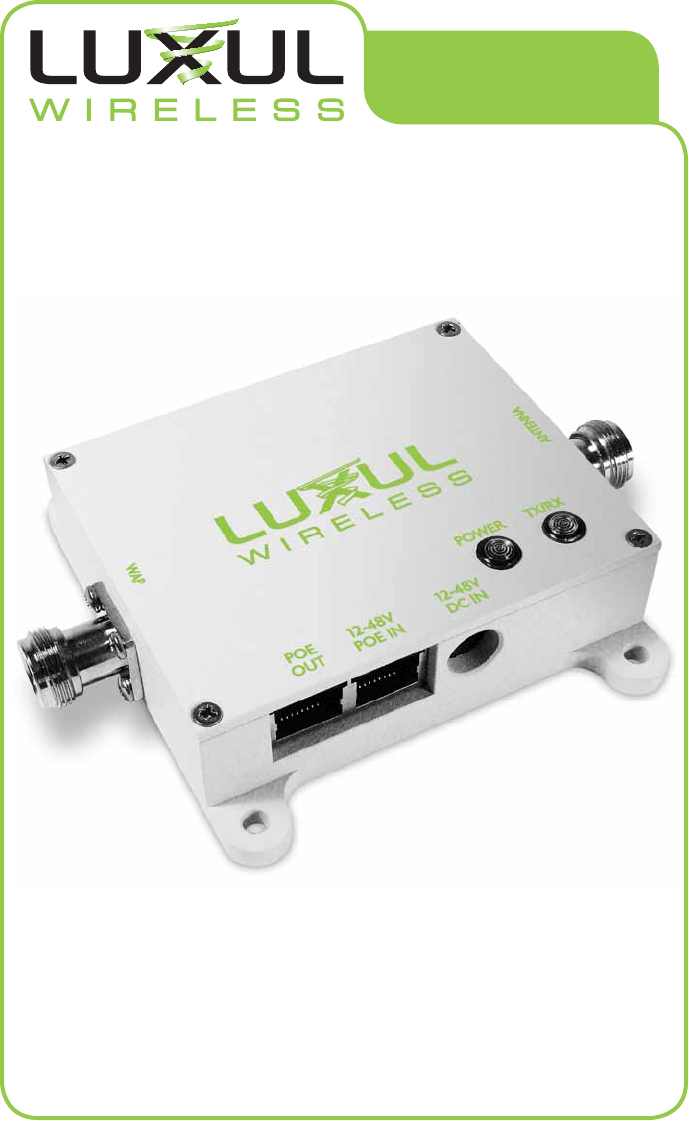
USER GUidE
PRo-WAV™
Wi-Fi RAnGE ExtEndER SYStEM
FoR USE With thE d-Link dWL-2100AP
ModEL nUMbER: PW-FC1 - SinGLE AntEnnA
PW-FC1 - dUAL AntEnnA
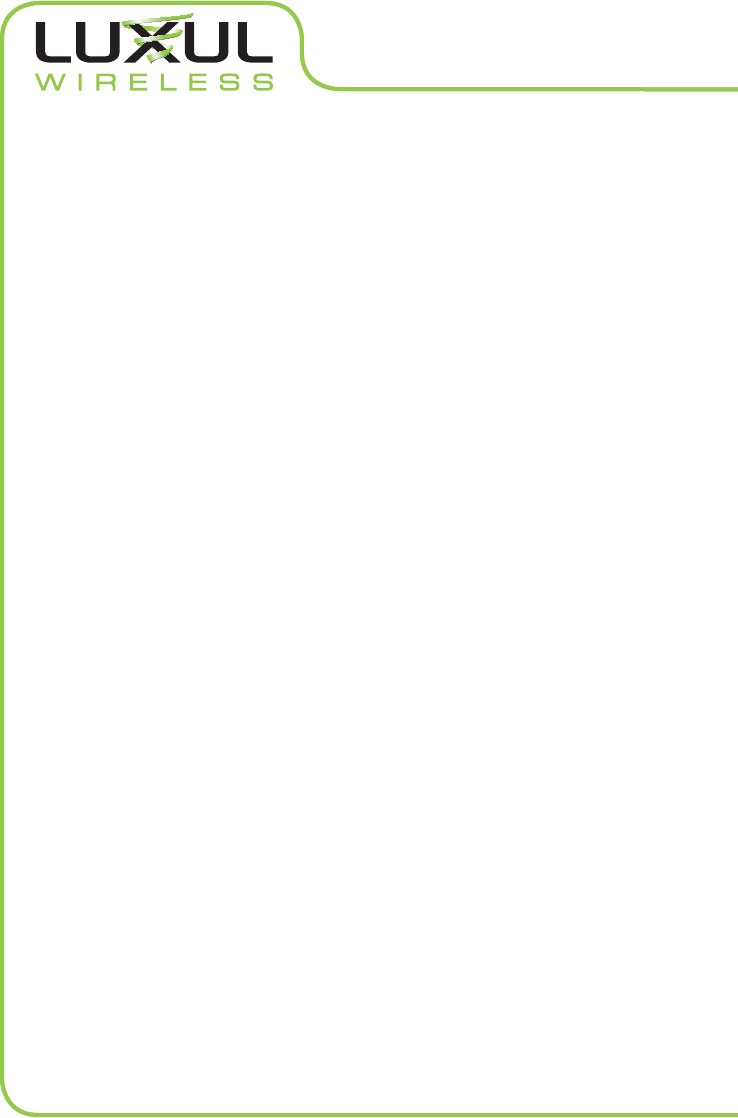
PRO-WAV WI-FI RANGE EXTENDER SYSTEM
MODEL NUMBER: PW-FC1
INSTALLATION GUIDE
© 2009 by Luxul Wireless, Inc. All rights reserved.
No part of this publication may be modified or adapted in any way, for any purposes without
permission in writing from Luxul Wireless, Inc. (Luxul). The material in this manual is subject to
change without notice. Luxul reserves the right to make changes to any product to improve
reliability, function, or design. No license is granted, either expressly or by implication or
otherwise under any Luxul Wireless, Inc., intellectual property rights. An implied license only
exists for equipment, circuits and subsystems contained in Luxul products.
Antenna for broadband wireless communications
This product is covered by one or more U.S. and foreign patents.
Patents: 7,379,717 6,606,075, 6,373,448, other patents pending
PRO-WAV WI-FI RANGE EXTENDER SYSTEM
MODEL NUMBER: PW-FC1
FCC ID: W59PWFC1
IC: 8584A-PWFC1
D-LINK WIRELESS ACCESS POINT
MODEL NUMBER: DWL-2100AP
FCC ID: RRK2004042018-1
IC: 4216A-WL2100AP
Luxul Wireless, Inc.
357 South 670 West, Suite 160
Lindon, UT 84042
www.luxulwireless.com

ShoCk-WAV SiGnAL booStER USER GUidE
1
CONTENTS
1 - INTRODUCTION . . . . . . . . . . . . . . . . . . . . . . . . . . . . . . . . . . . . . . . . . . . . . . . . . . . . . . . . . . . . 2
1.1 Document Conventions ................................................................2
1.2 Warnings..............................................................................2
1.3 Site Preparation .......................................................................3
1.4 Professional Installation Considerations.................................................3
2 - SPECIFICATIONS............................................................4
2.1 SHOCK-WAV™ WI-FI SIGNAL BOOSTER SPECIFICATIONS . . . . . . . . . . . . . . . . . . . . . . . . . . . . . . . . .4
2.2 X-WAV™ FLAT PANEL ANTENNA SPECIFICATIONS . . . . . . . . . . . . . . . . . . . . . . . . . . . . . . . . . . . . . . .4
3 - GETTING STARTED..........................................................5
3.1 Precautions ...........................................................................5
3.2 Package Contents .....................................................................5
3.3 Additional Items Required .............................................................6
4 - INSTALLATION PROCEDURES................................................6
4.1 Removing the Stock Antenna from the D-Link DWL-2100AP . . . . . . . . . . . . . . . . . . . . . . . . . . . . . .6
4.1 Connecting the PW-FC1 - Single Antenna to the D-Link DWL-2100AP. . . . . . . . . . . . . . . . . . . . . .7
4.2 Connecting the PW-FC1 - DUAL Antenna to the D-Link DWL-2100AP . . . . . . . . . . . . . . . . . . . . .7
4.3 Connecting Power and Data Source cables . . . . . . . . . . . . . . . . . . . . . . . . . . . . . . . . . . . . . . . . . . . . . .8
5 - ANTENNA PLACEMENT .....................................................8
5.1 Antenna Deployment..................................................................9
6 - REGULATORY COMPLIANCE ...............................................10
6.1 Health and Safety Recommendations..................................................11
6.2 RF Exposure Guidelines...............................................................11
6.3 Radio Frequency Interference Requirements—FCC . . . . . . . . . . . . . . . . . . . . . . . . . . . . . . . . . . . . . 12
6.4 Radio Transmitters (Part 15) ...........................................................12
6.5 Industry Canada ( RSS-Gen Issue 2)....................................................13
7 - SALES AND SUPPORT CONTACTS............................................13
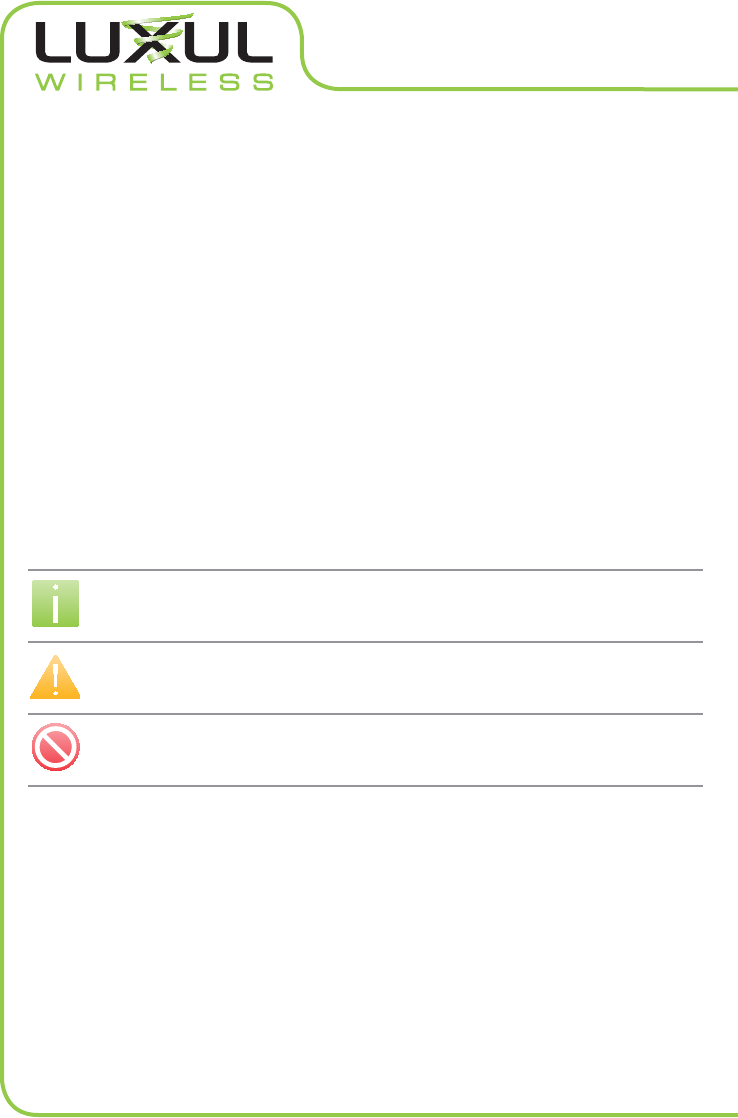
2
1 - INTRODUCTION
The Luxul Wireless Pro-WAV Wi-Fi Range Extender System is designed to complement and
enhance the performance of the D-Link DWL-2100AP Wireless Access Point (WAP). When
combined with the DWL-2100AP and X-WAV XW-24-FP7 Flat Panel Antenna, it delivers up to the
maximum approved transmit power, resulting in a farther reaching and higher performing network.
Luxul Wireless Pro-WAV Wi-Fi Range Extender System feature patented RF technology that
dynamically optimizes output strength and provides the cleanest, most consistent signal
amplification available for Wi-Fi networks. Designed for bidirectional signal amplification,
Shock-WAV Wi-Fi Signal Boosters utilize patented Digital Automatic Gain Control (D-AGC) tech-
nology that actively monitors the incoming signal from each packet and makes adjustments so
that the output signal maintains constant power levels, ensuring the cleanest and most consistent
RF signal possible.
1.1 DOCUMENT CONVENTIONS
The following graphical alerts are used in this document to indicate notable situations:
NOTE: Tips, hints, or special requirements that you should take note of.
CAUTION: Care is required. Disregarding a caution can result in data loss or
equipment malfunction.
WARNING!: Indicates a condition or procedure that could result in personal injury
or equipment damage.
1.2 WARNINGS
• Read all installation instructions and site survey reports, and verify correct equipment installation
before connecting the Shock-WAV Wi-Fi Signal Booster or DWL-2100AP to its power source.
• Remove jewelry and watches before installing this equipment.
• Verify that the unit is grounded before connecting it to the power source.
• Verify that any device connected to this unit is properly wired and grounded.
• Connect all power cords to a properly wired and grounded electrical circuit.
• Verify that the electrical circuits have appropriate overload protection.
• Attach only approved power cords to the device.
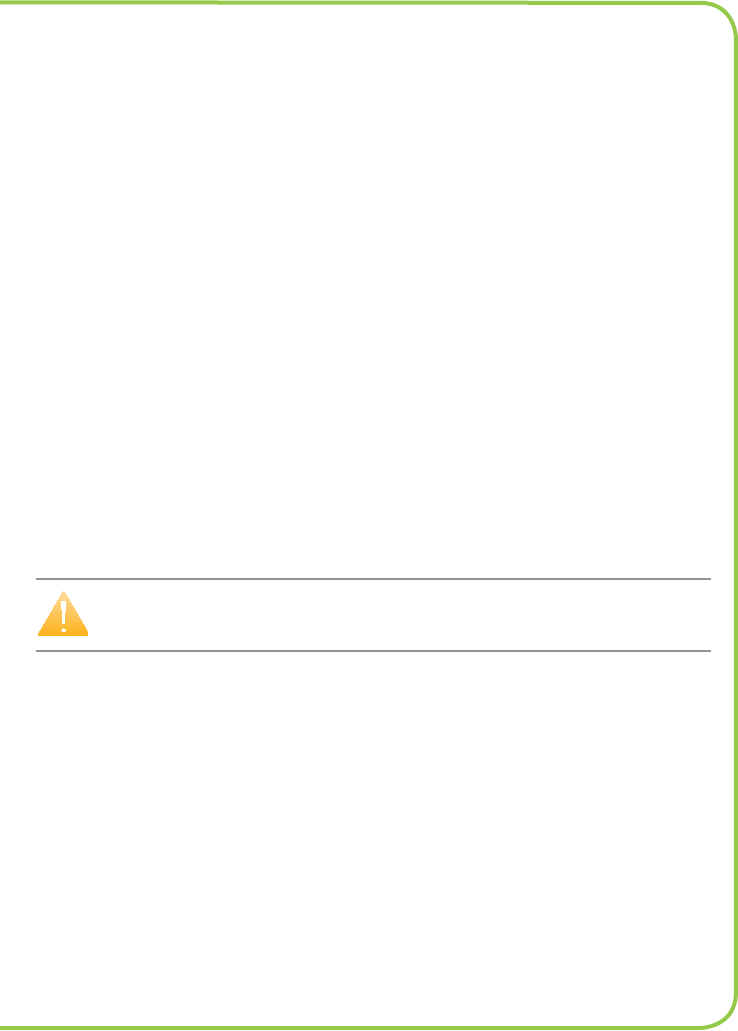
ShoCk-WAV SiGnAL booStER USER GUidE
3
• Verify that the power connector and socket are accessible at all times during the
operation of the equipment.
• Do not work with power circuits in dimly lit spaces.
• Do not install this equipment or work with its power circuits during thunderstorms or
other weather conditions that could cause a power surge.
• Verify there is adequate ventilation around the device, and that ambient temperatures meet
equipment operation specifications.
• Products outside the approved configurations may be in violation of Part 15 of the FCC Rules.
1.3 SITE PREPARATION
• Consult your site survey and network analysis reports to determine
specific equipment placement, power drops, and so on.
• Assign installation responsibility to the appropriate personnel.
• Identify and document where all installed components are located.
• Provide a sufficient number of power drops for your equipment.
• Ensure adequate, dust-free ventilation to all installed equipment.
• Identify and prepare Ethernet and console port connections.
• Verify that cable lengths are within the maximum allowable distances
for optimal and certified signal transmission.
1.4 PROFESSIONAL INSTALLATION CONSIDERATIONS
CAUTION: Operation of the signal booster without regulatory approval is illegal
The Luxul Wireless Pro-WAV Wi-Fi Range Extender System is required to be professionally
installed. The following components are approved for use in the system.
• Luxul PW-FC1 Wi-Fi Signal Booster
• Luxul Wireless X-WAV XW-24-FP7 Flat Panel Antenna
• D-Link DWL-2100AP Wireless Access Point
The output power of the amplifier is set and tested during manufacturing. There are no user
modifiable parameters in the amplifier. The Luxul Shock-WAV Wi-Fi Signal Booster system
incorporates a Digital AGC (D-AGC) that ensures a consistent and approved output power.
Please reference section 4 for installation instructions.
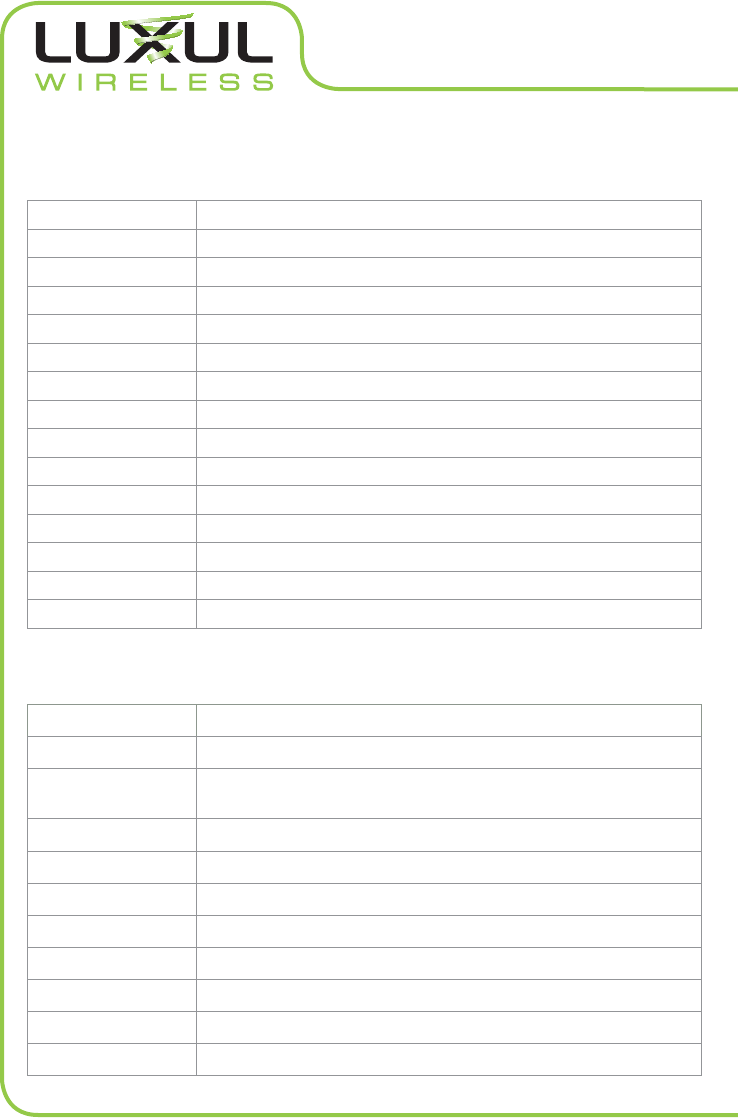
4
2 - SPECIFICATIONS
2.1 SHOCK-WAV™ WI-FI SIGNAL BOOSTER SPECIFICATIONS
Operating Range 2400 - 2483 MHz
Transmit Power (28dBm)
Transmit Gain 20dB Typical (under D-AGC Control)
Receive Gain 15dB Typical
TX Input Power +8dBm to +24dBm
Noise Figure 3.5dB Typical
LED Indicators TX\RX Red for Transmit, Green for Receive
Power Consumption 400mW (RX) 5W (TX) Max
Power Options Power Over Ethernet (POE) or AC-DC adapter
Operating Voltage 12 to 48VDC
Operating Temp -4 F to +122F (-20c - +50c)
Dimensions W: 4” (101.6mm) L: 5.16” (131mm) H: 1.13” (28.7mm)
Enclosure Indoor, Aluminum
RF Connectors Two (2) Type N Female
Weight 0.7lbs. (317.5g)
2.2 X-WAV™ FLAT PANEL ANTENNA SPECIFICATIONS
Frequency Range 2400 - 2500MHz
Gain 7dBi CP Gain
Polarization Clear-WAV
Right Hand Circular
Connector N Female
Azimuth Beam Width 70 degrees
Elevation Beam Width 70 degrees
VSWR < 1.5:1
F/B Ratio 23dB
Impedence 50 Ohm
Dimensions W: 4.25” (107.95mm), L: 4.25” (107.95mm) , H: 1.6” (40.64mm)
Weight 4.5 oz (127.5g)
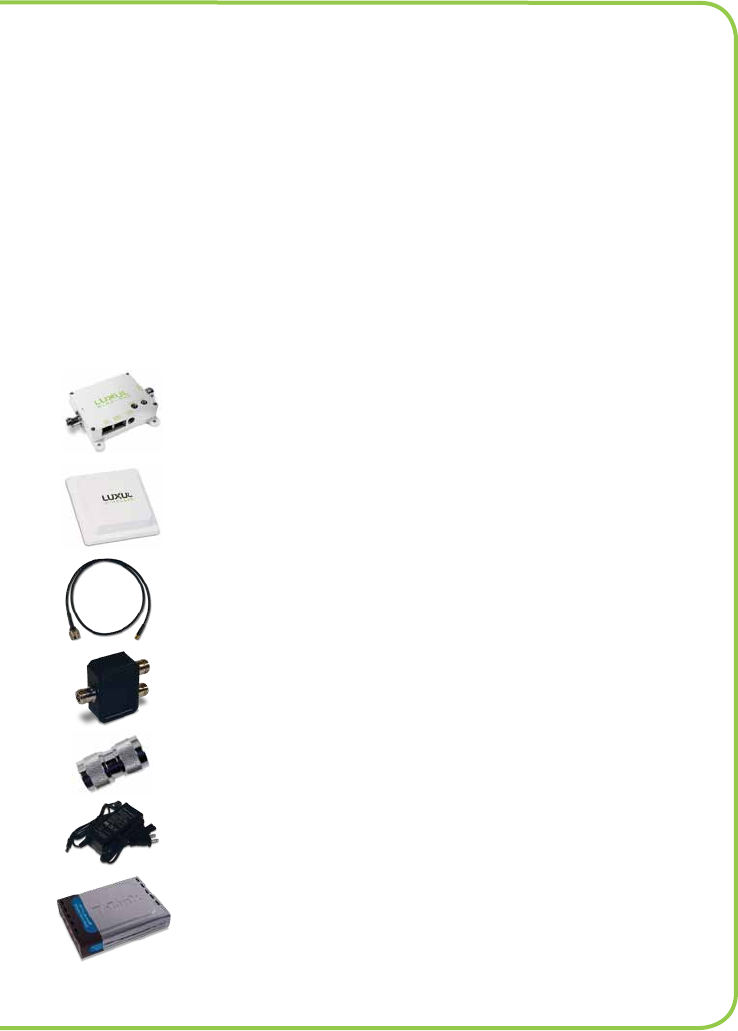
ShoCk-WAV SiGnAL booStER USER GUidE
5
3 - GETTING STARTED
3.1 PRECAUTIONS
Before installing the Shock-WAV Wi-Fi Signal Booster and DWL-2100AP verify the following:
• Do not install in wet or dusty areas without additional protection. Contact
a Luxul Wireless representative for more information.
• Verify the environment has a continuous temperature range between -4 F to +122F (-20c - +50c).
3.2 PACKAGE CONTENTS
The Luxul Wireless Pro-WAV Wi-Fi Range Extender System consists of the following:
One-Shock-WAV Wi-Fi Signal Booster
• PW-FC1 - Single Antenna: One-XW-24-FP7 - 7dBi High Gain 2.4GHz
• PW-FC1 - Dual Antenna: Two-XW-24-FP7 - 7dBi High Gain 2.4GHz
• PW-FC1 - Single Antenna: Two-Coax cables
(1-N-Male to N-Male, 1-N-Male to RP-SMA)
• PW-FC1 - Dual Antenna: Three-Coax cables
(2-N-Male to N-Male, 1-N-Male to RP-SMA, RP-SMA to 1-RP-TNC adapter)
PW-FC1 - Dual Antenna only:
One-Signal Splitter (S50-2502N) and Barrel Connector
PW-FC1 - Dual Antenna only:
One-Barrel Connector
One-48VDC Universal Input Power Supply
One-D-Link DWL-2100AP Wireless access point
Included with the D-Link DWL-2100AP is: a Detachable Antenna, Ethernet Cable,
Power Supply, Mounting kit, Vertical Stand, Installation Guide and CD ROM
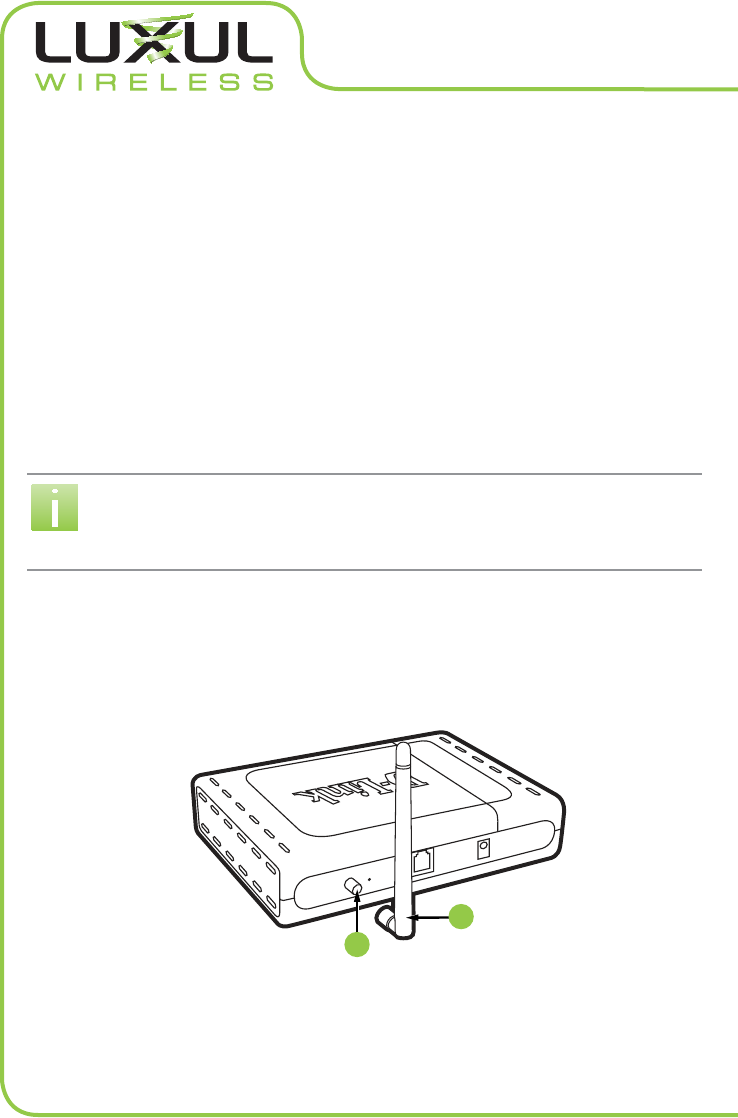
6
3.3 ADDITIONAL ITEMS REQUIRED
Before installing your Shock-WAV Wi-Fi Signal Booster, be sure to have the following
items available:
• Ethernet cable for connection to your network source
3.4 OPTIONAL PRODUCTS AND ACCESSORIES
Splitters and Surge Protectors: Signal splitters, lightning surge protectors, and other useful
accessories are available for making the most of your Luxul Wireless purchase.
4 - INSTALLATION PROCEDURES
NOTE: The combination of the D-Link DWL-2100AP and the Shock-WAV Wi-Fi
Signal Booster requires professional installation. Please contact Luxul
Wireless for more information.
4.1 REMOVING THE STOCK ANTENNA FROM THE D-LINK DWL-2100AP
Shock-WAV Wi-Fi Signal Boosters are connected between the DWL-2100AP and the
X-WAV antenna.
Figure 1
1
2
Remove the stock antenna (Figure 1) 1 from your DWL-2100AP’s Antenna port 2.
(Consult your D-Link documentation for more details on the DWL-2100AP’s ports).
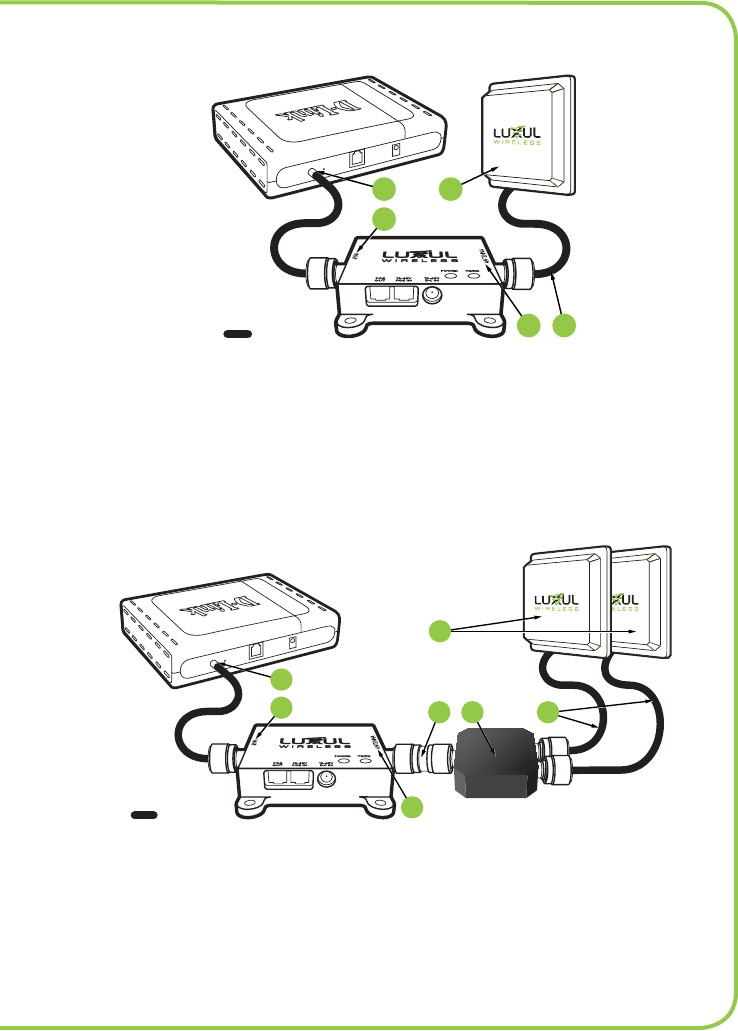
ShoCk-WAV SiGnAL booStER USER GUidE
7
4.1 CONNECTING THE PW-FC1 - SINGLE ANTENNA TO THE D-LINK DWL-2100AP
Figure 2 Coax Cable
2
3
4
51
Using the supplied N-Male to RP-SMA-Male coax cable, connect the Shock-WAV Wi-Fi Signal
Booster to your DWL-2100AP’s Antenna port . (Figure 2 ) 1. Be sure to connect the cable to
the side of the Signal Booster labeled WAP 2. Next use the included N-Male to N-Male cable
3 connect the Shock-WAV Wi-Fi Signal Booster to the X-WAV XW-24-FP7 antenna 5. Be sure
to connect the cable to the side of the Signal Booster labeled Antenna 4.
4.2 CONNECTING THE PW-FC1 - DUAL ANTENNA TO THE D-LINK DWL-2100AP
Figure 3 Coax Cable
2
3
1
45 6
7
Using the supplied N-Male to RP-SMA-Male coax cable, connect the Shock-WAV Wi-Fi Signal
Booster to your DWL-2100AP’s Antenna port . (Figure 3 ) 1. Be sure to connect the cable to
the side of the Signal Booster labeled WAP 2. Next use the included barrel connector 4 to
connect the splitter 4 to the side of the Signal Booster labeled Antenna 3. Using the two
N-Male to N-Male cables 6 connect the Splitter to the two X-WAV XW-24-FP7 antennas 7.
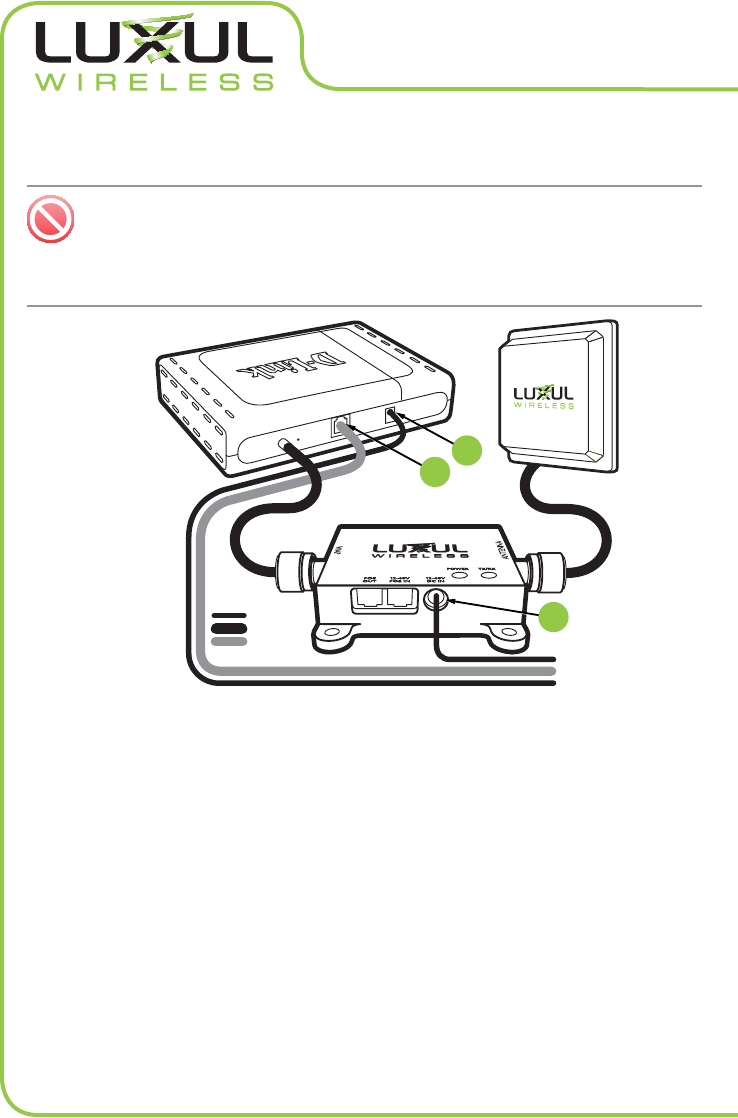
8
4.3 CONNECTING POWER AND DATA SOURCE CABLES
WARNING!: Do not attempt to connect or disconnect any components while the
D-Link DWL-2100AP WAP or Shock-WAV signal booster are plugged
into power. Doing so may cause equipment damage and/or physical
injury and will void your warranty.
Figure 4
3
1
2
Power Supply
Coax Cable
Ethernet
Power
Data Source
Power
Power connections are the same for both PW-FC1 units. The PW-FC1 - Single antenna is show in
figure 4. Connect your Data source Ethernet cable to the LAN port on the back of the D-Link
DWL-2100AP, (Figure 4) 1. Connect the D-Link Power supply the power port on the back of
the DWL-2100AP 2. Connect the 48V AC-DC power supply to the Signal Booster port labeled,
12-48V DC IN 3. Plug the power supplies into your 100-240V compatible power source.
(Consult your D-Link Documentation for more information on the DWL-2100AP).
5 - ANTENNA PLACEMENT
Luxul Wireless products, particularly those implementing our patented signal booster technology,
are often capable of emitting enough signal strength to cover the desired area regardless of
orientation. For best results, the Antenna should be deployed where the maximum amount of
signal can be sent throughout the desired coverage area.
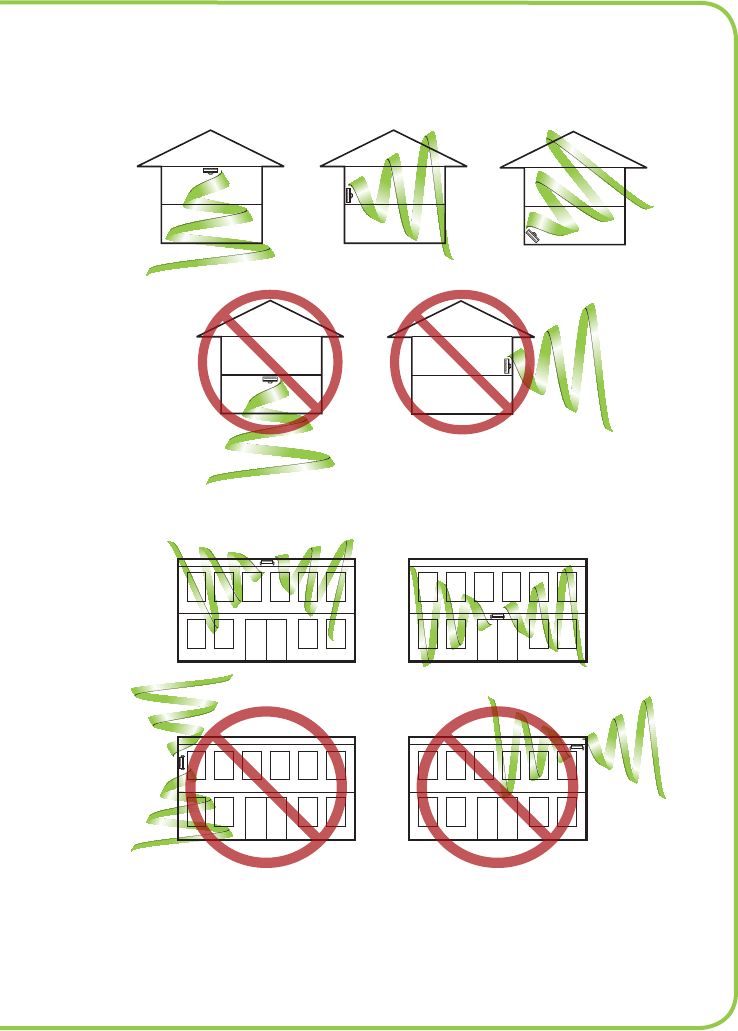
ShoCk-WAV SiGnAL booStER USER GUidE
9
5.1 ANTENNA DEPLOYMENT
Be sure you place the antenna so there is a minimum of 2 feet (.6 meters) of open space around it.
Figure 5
Figure 6
Figure 5 (Single antenna) and 6 (Dual Antenna) show the recommended Antenna deployments
and how loss of the signal coverage can happen due to bad antenna placement.
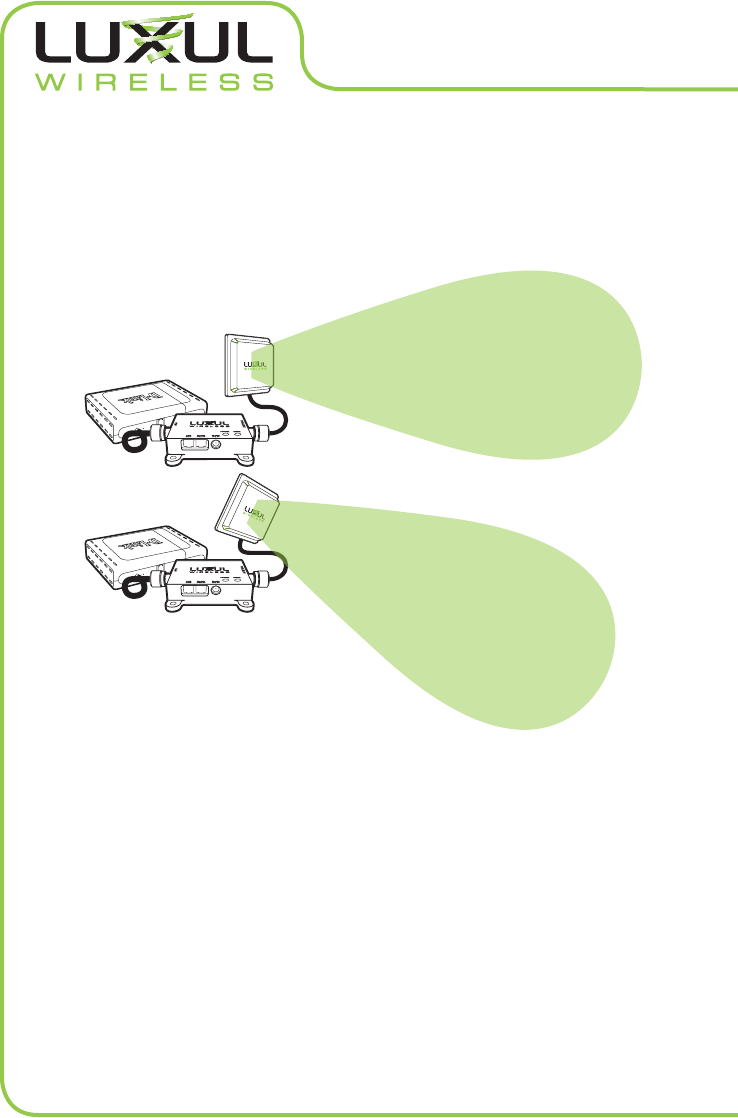
10
5.2 ANTENNA DIRECTION
For maximum coverage it is important to have your antenna pattern radiating in the correct
direction. The pattern radiates out in a cone shape pattern away from the antenna. If the
antenna is tipped at an angle, the pattern will radiate out at that angle. See Figure 7 for an
example of pattern radiation.
Figure 7
6 - REGULATORY COMPLIANCE
This device is approved under the Luxul Wireless brand and designed to comply for use spe-
cifically with the D-Link DWL-2100AP. This device is designed to be compliant with rules and
regulations in locations where they are sold and will be labeled as required. Any changes or
modifications to Luxul equipment, not expressly approved by Luxul, could void the user’s au-
thority to operate the equipment. This Luxul device when used in conjunction with the D-Link
DWL-2100AP should be professionally installed and the Radio Frequency Output Power will
not exceed the maximum allowable limit for those countries that have regulatory approval.
Antennas: Use only the supplied or an approved replacement antennas. Unauthorized anten-
nas, modifications, or attachments could cause damage and may violate regulatory approvals.

ShoCk-WAV SiGnAL booStER USER GUidE
11
6.1 HEALTH AND SAFETY RECOMMENDATIONS
Warnings for the use of Wireless Devices: Please observe all warning notices with regard to
the usage of wireless devices
Potentially Hazardous Atmospheres: You are reminded of the need to observe restrictions on
the use of radio devices in fuel depots, chemical plants etc. and areas where the air contains
chemicals or particles (such as grain, dust, or metal powders).
Safety in Hospitals: Wireless devices transmit radio frequency energy and may affect medical
electrical equipment. When installed adjacent to other equipment, it is advised to verify that
the adjacent equipment is not adversely affected.
Power Supply: Use only a Luxul approved power supply output rated at 48VDC and
minimum 0.25A. The power supply shall be Listed to UL/CSA 60950-1; and certified to
IEC60950-1 and EN60950-1 with SELV outputs. The device can also be powered from a
compliant POE source. Use of alternative power supply will invalidate any approval given
to this device and may be dangerous.
6.2 RF EXPOSURE GUIDELINES
Safety Information: The device complies with internationally recognized standards covering
human exposure to electromagnetic fields from radio devices.
Warning: Exposure To Radio Frequency (RF) Radiation:
• The radiated output of this device is below the FCC radio frequency exposure limits.
Nevertheless, the device should be used in such a manner that the potential for human
contact during normal operation is minimized.
• The end user must avoid any extended human RF exposure directly in front of the Model
PW-FC1, up to a distance of 20cm, when unit is switched on.
• When servicing the equipment and selecting a location for the antennas, it is important to
note that a minimum distance of 20cm is required between personnel and the Model PW-
FC1 antennas to comply with the radio frequency exposure limit.
• The antenna used for this transmitter must be installed to provide a separation distance
of at least 20cm from all persons and must not be co-located or operating in conjunction
with any other antenna or transmitter.
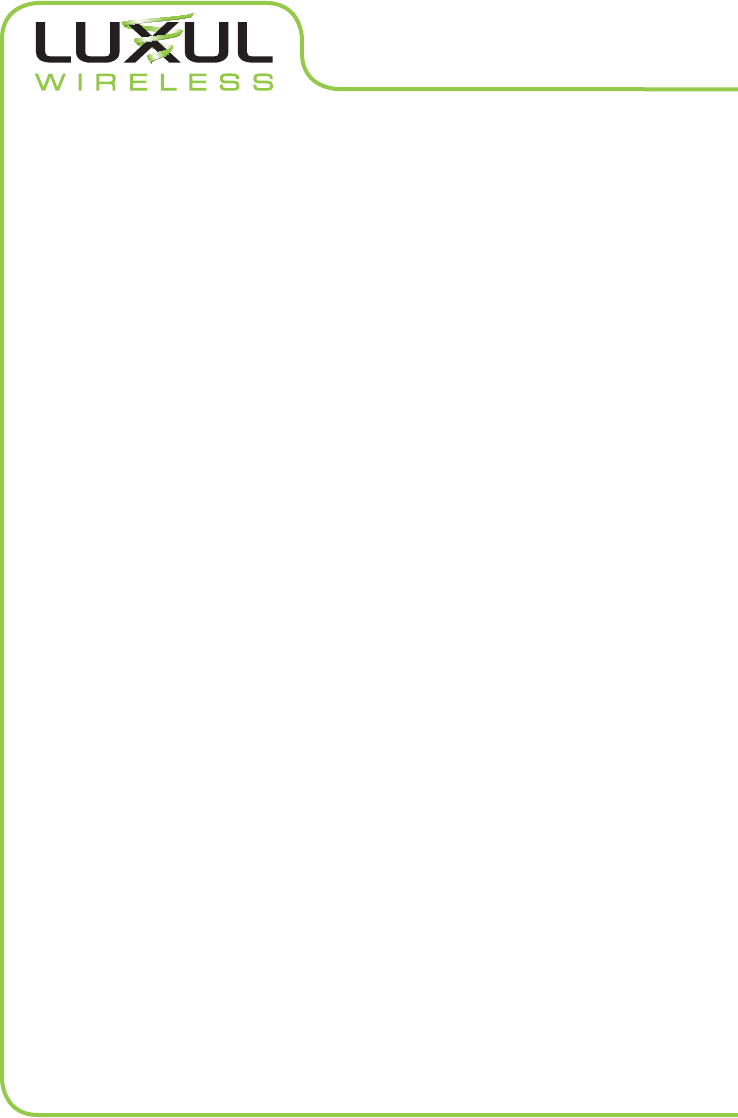
12
• The following safety precautions should be observed:
− Do not touch or move the antenna while the unit is transmitting or receiving.
− Do not hold any component containing the radio such that the antenna is very close or
touching any exposed parts of the body, especially the face or eyes, while transmitting.
− Do not operate the radio or attempt to transmit data unless the antenna is connected;
this behavior may cause damage to the radio.
Remote and Standalone Antenna Configurations: To comply with FCC RF exposure require-
ments, antennas that are mounted externally at remote locations or operating near users
at stand-alone desktop of similar configurations must operate with a minimum separation
distance of 20 cm from all persons.
6.3 RADIO FREQUENCY INTERFERENCE REQUIREMENTS—FCC
This equipment has been tested and found to comply with the limits for a Class B digital
device, pursuant to Part 15 of the FCC rules. These limits are designed to provide reasonable
protection against harmful interference in a residential installation. This equipment generates,
uses and can radiate radio frequency energy and, if not installed and used in accordance with
the instructions, may cause harmful interference to radio communications. However there is
no guarantee that interference will not occur in a particular installation. If this equipment does
cause harmful interference to radio or television reception, which can be determined by turn-
ing the equipment off and on, the user is encouraged to try to correct the interference by one
or more of the following measures:
• Reorient or relocate the receiving antenna
• Increase the separation between the equipment and receiver
• Connect the equipment into an outlet on a circuit different from that to
which the receiver is connected
• Consult the dealer or an experienced radio/TV technician for help.
6.4 RADIO TRANSMITTERS (PART 15)
This device complies with Part 15 of the FCC Rules. Operation is subject to the
following two conditions: (1) this device may not cause harmful interference, and
(2) this device must accept any interference received, including interference that
may cause undesired operation.

ShoCk-WAV SiGnAL booStER USER GUidE
13
6.5 INDUSTRY CANADA ( RSS-GEN ISSUE 2)
In accordance with Industry Canada Regulations, this radio frequency power amplifier may
only be used with a transmitter with which the amplifier has been certified by Industry Canada.
The Industry Canada Identification Number for the transmitter with which this amplifier is
permitted to operate is 4216A-WL2100AP
This PW-FC1 - Single Antenna is designed to work with one XW-24-FP7 antenna. This PW-FC1 -
dual Antenna is designed to work with two XW-24-FP7 antennas. The XW-24-FP7 antenna has a
maximum linear gain of 4dBi or maximum CP gain of 7dBi. Any antenna having a gain greater than
4dBi are strictly prohibited for use with this device. The required antenna impedance is 50 ohms.
Operation is subject to the following two conditions: (1) this device may not cause interfer-
ence, and (2) this device must accept any interference, including interference that may cause
undesired operation of the device.
To reduce potential radio interference to other users, the antenna type and its gain should
be so chosen that the equivalent isotropically radiated power (e.i.r.p.) is not more than that
permitted for successful communication.
7 - SALES AND SUPPORT CONTACTS
For Sales Assistance:
Luxul Wireless
357 South 670 West, Suite 160
Lindon, UT 84042
sales@luxulwireless.com
For Technical Assistance:
Luxul Wireless
357 South 670 West, Suite 160
Lindon, UT 84042
support@luxulwireless.com
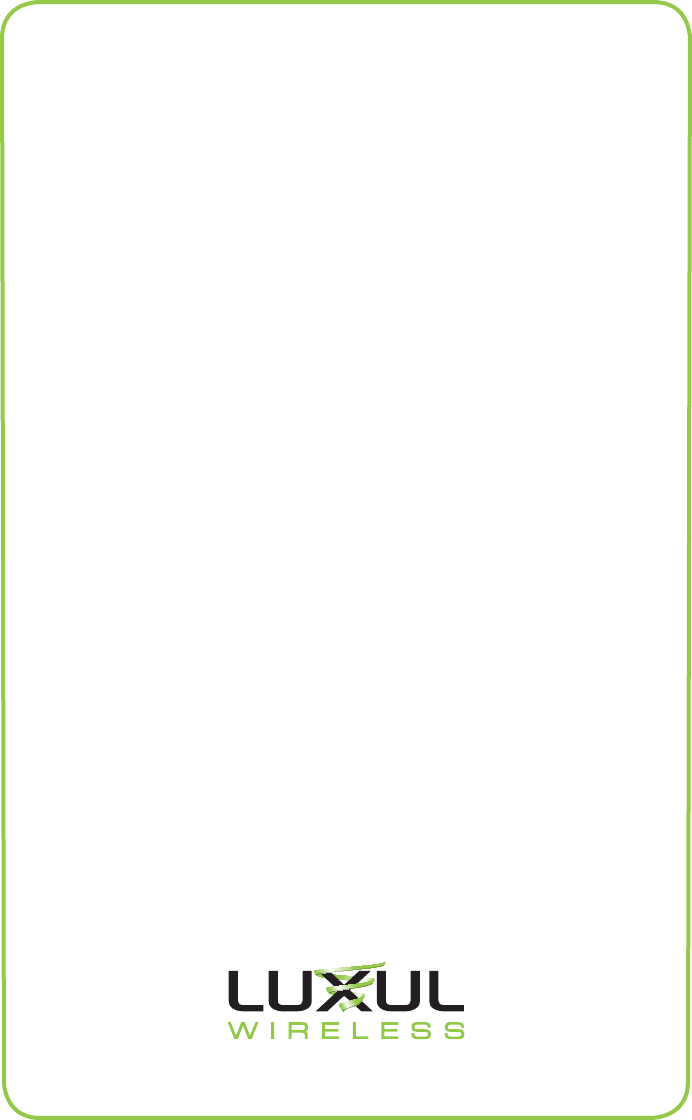
© 2009 Luxul Corp. All rights reserved.
Results may vary depending on building layout, type of construction and other environmental factors
including Wi-Fi traffic, Microwaves Ovens, Cordless Phones, etc.
FCC NOTICE: The use of all radio equipment is subject to regulations in each country. To comply with FCC part 15
rules in the United States, radio equipment must only be used in systems that have been FCC certified. It is the
responsibility of the user/professional installer/operator to ensure that only approved equipment/systems are
deployed. To ensure FCC part 15 compliance, Luxul amplifier products should only be installed in certified systems by
licensed professionals.
FCC Certification Support for OEMs: Luxul Wireless offers FCC certification assistance and engineering support for
qualified OEM’s interested in certifying complete amplified WLAN systems. Please contact us for details.
LUXUL WIRELESS | 357 South 670 West, Lindon, UT, 84042
p: 801-822-5450 f: 801-822-5460
www.luxulwireless.com
LUX-UG-101320090257-PW-FC1-DLINKDWL2100AP